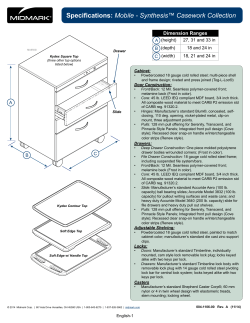
slides
Transactions
Recap so far…
!
We discussed:
!
!
!
!
!
Serial schedules, serializability
Conflict-serializability, view-serializability
How to check for conflict-serializability
Recoverability, cascade-less schedules
We haven’t discussed:
!
How to guarantee serializability ?
!
!
Allowing transactions to run, and then aborting them if the schedules
are not serializable is clearly not the way to go
We instead use schemes to guarantee that the schedule will be
conflict-serializable
Concurrency Control
Lock instructions
!
New instructions
Not enough to take minimum
locks when you need to
read/write something!
- lock-S: shared lock request
- lock-X: exclusive lock request
- unlock: release previously held lock
Example schedule:
T1
lock-X(B)
read(B)
B "B-50
write(B)
unlock(B)
lock-X(A)
read(A)
A "A + 50
write(A)
unlock(A)
T2
lock-S(A)
read(A)
unlock(A)
lock-S(B)
?
read(B)
unlock(B)
display(A+B)
2-Phase Locking Protocol (2PL)
!
Phase 1: Growing phase
!
!
!
lock-X(B)
read(B)
B "B-50
write(B)
unlock(B)
Phase 2: Shrinking phase
!
!
T1
Transaction may obtain locks
But may not release them
Only release locks
2PL guarantees conflictserializability
!
!
lock-X(A)
read(A)
A "A + 50
write(A)
unlock(A)
lock-point: the time at which a
transaction acquired last lock
if lock-point(T1) < lockpoint(T2), there can’t be an
edge from T2 to T1 in the
precedence graph
2 Phase Locking
!
Example: T1 in 2PL
T1
Growing phase
Shrinking phase
{
{
lock-X(B)
read(B)
B " B - 50
write(B)
lock-X(A)
read(A)
A " A - 50
write(A)
unlock(B)
unlock(A)
2 Phase Locking
!
Guarantees conflict-serializability, but not cascadeless recoverability
T1
T2
T3
lock-X(A), lock-S(B)
read(A)
read(B)
write(A)
unlock(A), unlock(B)
lock-X(A)
read(A)
write(A)
unlock(A)
commit
lock-S(A)
read(A)
commit
<xction fails>
2 Phase Locking
!
Guarantees conflict-serializability, but not
cascade-less recoverability
!
Guaranteeing just recoverability:
!
!
!
If T2 reads a dirty data of T1 (ie, T1 has not
committed), then T2 can’t commit unless T1 either
commits or aborts
If T1 commits, T2 can proceed with committing
If T1 aborts, T2 must abort
!
So cascades still happen
Strict 2PL
!
Release exclusive locks only at the very
end, just before commit or abort
T1
T2
T3
lock-X(A), lock-S(B)
read(A)
read(B)
write(A)
unlock(A), unlock(B)
lock-X(A)
read(A)
write(A)
unlock(A)
Commit
Strict 2PL
will not
allow that
lock-S(A)
read(A)
Commit
<xction fails>
Works. Guarantees cascade-less and recoverable schedules.
Strict 2PL
!
Release exclusive locks only at the very
end, just before commit or abort
!
!
Read locks are not important
Rigorous 2PL: Release both exclusive and
read locks only at the very end
!
!
The serializability order === the commit order
More intuitive behavior for the users
!
No difference for the system
Strict 2PL
!
Lock conversion:
!
Transaction might not be sure what it needs a
write lock on
!
Start with a S lock
!
Upgrade to an X lock later if needed
!
Doesn’t change any of the other properties of
the protocol
Implementation of Locking
!
A separate process, or a separate module
!
Uses a lock table to keep track of currently
assigned locks and the requests for locks
!
Read up in the book
Recap so far…
!
Concurrency Control Scheme
!
!
Lock-based protocols
!
!
Use locks to prevent multiple transactions accessing the
same data items
2 Phase Locking
!
!
A way to guarantee serializability, recoverability etc
Locks acquired during growing phase, released during
shrinking phase
Strict 2PL, Rigorous 2PL
More Locking Issues: Deadlocks
No xction proceeds:
Deadlock
- T1 waits for T2 to unlock A
- T2 waits for T1 to unlock B
!
T1
T2
lock-X(B)
read(B)
B " B-50
write(B)
lock-S(A)
read(A)
lock-S(B)
lock-X(A)
Rolling back transactions can be costly...
Deadlocks
!
T1
2PL does not prevent deadlock
Strict doesn’t either
!
T2
lock-X(B)
read(B)
B " B-50
write(B)
lock-S(A)
read(A)
lock-S(B)
lock-X(A)
Rolling back transactions can be costly...
Preventing deadlocks
!
Graph-based protocols
! Acquire locks only in a well-known order
bad
T1
good
T2
T1
lock-X(B)
lock-X(A)
read(B)
lock-X(B)
B " B-50
read(B)
write(B)
B " B-50
lock-S(A)
write(B)
read(A)
lock-S(A)
lock-S(B)
read(A)
lock-X(A)
!
T2
Might not know locks in advance
lock-S(B)
Detecting existing deadlocks
!
!
Timeouts (local information)
waits-for graph (global information):
!
edge Ti # Tj when Ti waiting for Tj
T1
T2
T3
T2
T4
T4
X(Z)
T1
X(V)
X(W)
T3
S(V)
S(W)
S(V)
Suppose T4 requests lock-S(Z)....
Dealing with Deadlocks
!
Deadlock detected, now what ?
!
!
Victim selection
!
Use time-stamps; say T1 is older than T2
!
wait-die scheme: T1 will wait for T2. T2 will not wait for T1; instead it will
abort and restart
wound-wait scheme: T1 will wound T2 (force it to abort) if it needs a lock
that T2 currently has; T2 will wait for T1.
!
!
Will need to abort some transaction
Issues
!
!
Prefer to prefer transactions with the most work done
Possibility of starvation
!
If a transaction is aborted too many times, it may be given
priority in continuing
Locking granularity
Locking granularity
!
Locking granularity
!
!
What are we taking locks on ? Tables, tuples, attributes ?
Coarse granularity
!
!
!
!
(not always done)
e.g. take locks on tables
less overhead (the number of tables is not that high)
very low concurrency
Fine granularity
!
!
!
!
e.g. take locks on tuples
much higher overhead
much higher concurrency
What if I want to lock 90% of the tuples of a table ?
!
Prefer to lock the whole table in that case
Granularity Hierarchy
The highest level in the example hierarchy is the entire database.
The levels below are of type area, file or relation and record in that
order.
Can lock at any level in the hierarchy
Granularity Hierarchy
!
New lock mode, called intentional locks
!
!
Declare an intention to lock parts of the subtree below a node
IS: intention shared
!
!
!
IX: intention exclusive
SIX: shared and intention-exclusive
!
!
The lower levels below may be locked in the shared mode
The entire subtree is locked in the shared mode, but I might also want
to get exclusive locks on the nodes below
Protocol:
!
!
If you want to acquire a lock on a data item, all the ancestors
must be locked as well, at least in the intentional mode
So you always start at the top root node
Granularity Hierarchy
(1) Want to lock F_a in shared mode, DB and A1 must be locked in at
least IS mode (but IX, SIX, S, X are okay too)
(2) Want to lock rc1 in exclusive mode, DB, A2,Fc must be locked in at
least IX mode (SIX, X are okay too)
Compatibility Matrix with Intention Lock Modes
!
Locks from different transactions:
requestor
IS
holder
IX
S
S IX
X
$
$
×
IS
$
IX
$
$
×
×
×
S
$
×
$
×
×
S IX
$
×
×
×
×
X
×
×
×
×
×
$
Example
T1(IS) , T2(IX)
R1
t1
t2
t4
t3
T2(X)
T1(S)
Examples
T1(IX)
T1(IS)
R
t1
T1(IX)
R
t2
t3
t4
t1
T1(S)
t3
t2
t4
T1(X)
f2.1
f2.2
f4.2
f4.2
f2.1
f4.2
f2.2
T1(SIX)
Can T2 access object f2.2 in X mode?
What locks will T2 get?
R
t1
T1(IX)
t2
t3
t4
T1(X)
f2.1
f2.2
f4.2
f4.2
f4.2
© Copyright 2025










